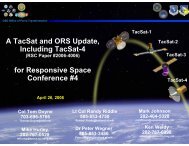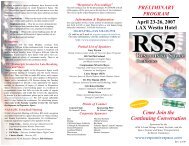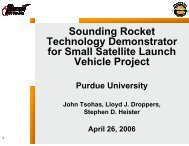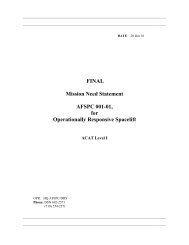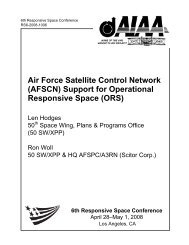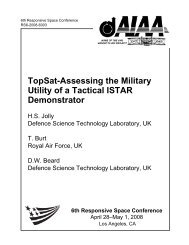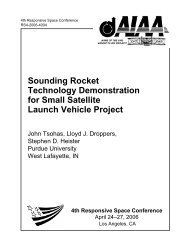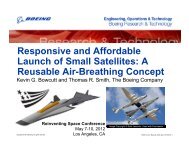Small Cell Lithium-Ion Batteries: The Responsive Solution for Space ...
Small Cell Lithium-Ion Batteries: The Responsive Solution for Space ...
Small Cell Lithium-Ion Batteries: The Responsive Solution for Space ...
Create successful ePaper yourself
Turn your PDF publications into a flip-book with our unique Google optimized e-Paper software.
3rd <strong>Responsive</strong> <strong>Space</strong> Conference<br />
RS3-2005-5003<br />
<strong>Small</strong> <strong>Cell</strong> <strong>Lithium</strong>-<strong>Ion</strong> <strong>Batteries</strong>:<br />
<strong>The</strong> <strong>Responsive</strong> <strong>Solution</strong> <strong>for</strong><br />
<strong>Space</strong> Energy Storage<br />
Chris Pearson<br />
AEA Technology<br />
Boulder, CO<br />
Carl Thwaite<br />
AEA Technology<br />
Ox<strong>for</strong>d, United Kingdom<br />
Nick Russel<br />
AEA Technology<br />
Ox<strong>for</strong>d, United Kingdom<br />
3rd <strong>Responsive</strong> <strong>Space</strong> Conference<br />
April 25–28, 2005<br />
Los Angeles, CA
AIAA RS3-2005-5003<br />
3 rd <strong>Responsive</strong> <strong>Space</strong> Conference 2005<br />
SMALL CELL LITHIUM-ION BATTERIES: THE RESPONSIVE SOLUTION FOR<br />
SPACE ENERGY STORAGE<br />
Chris Pearson (Boulder, Colorado), chris_pearson@uk.aeat.com<br />
Carl Thwaite (Ox<strong>for</strong>d, United Kingdom) Carl_Thwaite@uk.aeat.com<br />
Nick Russel (Ox<strong>for</strong>d, United Kingdom), , Nick_Russel@uk.aeat.com<br />
(All authors AEA Technology)<br />
ABSTRACT<br />
During a solar eclipse, spacecraft rely on batteries<br />
to power all on-board electrical systems. Advances<br />
in battery technology have led to lighter products<br />
that, in turn, allow spacecraft to carry heavier and<br />
more capable payloads. AEA Technology has<br />
pioneered the current state of the art in the space<br />
community: ‘small-cell’ <strong>Lithium</strong>-ion battery<br />
technology. This paper focuses on the direct<br />
applicability, and benefits, of this approach to<br />
<strong>Responsive</strong> <strong>Space</strong>.<br />
Traditionally, space batteries consisted of a single<br />
series connected string of ‘large cells’. Large cells<br />
are sized (in terms of capacity) according to<br />
mission requirements, meaning that cell<br />
qualification programmes <strong>for</strong> individual missions<br />
are common. <strong>The</strong> small cell approach involves<br />
taking Commercially available Off <strong>The</strong> Shelf<br />
(COTS) <strong>Lithium</strong>-ion cells, qualifying them <strong>for</strong><br />
space, and using a strict batch test and screening<br />
process to ensure the continued quality of cell<br />
batches <strong>for</strong> space flight. This obviates the need <strong>for</strong><br />
cell qualification <strong>for</strong> each programme.<br />
<strong>The</strong> technology has proved to be ideal <strong>for</strong> small<br />
satellite missions, due to the low-cost of small cell<br />
battery designs compared to rival large cell energy<br />
storage solutions. <strong>The</strong> maturity of the design<br />
concept, and there<strong>for</strong>e low risk of utilisation,<br />
allows Protoflight programmes to be adopted <strong>for</strong> all<br />
but the most specialised of applications. A<br />
protoflight programme reduces cost due to the lack<br />
of need <strong>for</strong> a dedicated qualification battery unit<br />
and test programme.<br />
Copyright © 2005 by AEA Technology. Published by AIAA 3 rd<br />
<strong>Responsive</strong> <strong>Space</strong> Conference 2005 with permission.<br />
RESPONSIVE SPACE: SPACECRAFT<br />
COMPONENT REQUIREMENTS<br />
Encouraged by the Department of Defense,<br />
manysections of the United States military space<br />
community wish to achieve faster mission response<br />
and turnaround, reduced life-cycle mission costs<br />
and more streamlined programme execution.<br />
Successful achievement of these goals will enable<br />
quick-reaction, tailored systems designed to meet<br />
the immediate needs of warfighters.<br />
<strong>The</strong> <strong>Responsive</strong> <strong>Space</strong> Conference focuses on the<br />
specific challenges that must be overcome to<br />
facilitate the “the return of data from space<br />
returned within hour of an identified need” 1 . One<br />
objective of the 3 rd <strong>Responsive</strong> <strong>Space</strong> Conference,<br />
<strong>for</strong> which this paper has been produced, is to<br />
examine the present responsiveness of space<br />
system components in this context.<br />
Launch vehicles require energy storage devices to<br />
power on-board systems such as thrust vector<br />
control, avionics, pyrotechnics and self-destruct<br />
system. <strong>The</strong> vast majority of spacecraft (except<br />
missions powered by radioisotope thermoelectric<br />
generators) receive electrical power during periods<br />
of solar array shadowing (due to orbital effects)<br />
from batteries. Thus, batteries are a mission<br />
critical item since their malfunction would lead to<br />
failure to reach orbit or the inability to use a<br />
spacecraft during eclipse (almost 40% of the time<br />
in Low Earth Orbit).<br />
To meet the needs of <strong>Responsive</strong> <strong>Space</strong>, spacecraft<br />
and launch vehicle batteries must be able to exhibit<br />
the following features:<br />
• Reduced unit lead-time. In fact, to meet<br />
the end goals of <strong>Responsive</strong> <strong>Space</strong>, it must<br />
1 of 13<br />
AIAA 3 rd <strong>Responsive</strong> <strong>Space</strong> Conference 2005
e possible to ‘stock-pile’ flight batteries<br />
<strong>for</strong> extended periods. Further, the time<br />
required to make batteries flight ready<br />
must be in the order of only a few hours.<br />
• Continued high reliability whilst reducing<br />
non-recurring and recurring engineering<br />
costs.<br />
• <strong>Batteries</strong> must be simple to operate. <strong>The</strong><br />
importance of this feature should not be<br />
overlooked, as rapid pre-launch checkout<br />
and minimal on-orbit housekeeping are<br />
essential <strong>for</strong> mission level simplification.<br />
This paper examines the potential of both the<br />
‘small-cell’ and ‘large-cell’ <strong>Lithium</strong>-ion approach<br />
to meet the goals of <strong>Responsive</strong> <strong>Space</strong>.<br />
LITHIUM-ION BATTERY TECHNOLOGY<br />
<strong>Space</strong> applications require lightweight technology<br />
due to the finite lift capacity of Launch Vehicles.<br />
Consequently, in order to carry the maximum<br />
possible quantity and quality of payload equipment<br />
that maintains the general health and safety of<br />
spacecraft and launch vehicles must be as light as<br />
possible. <strong>Batteries</strong> make up a significant portion of<br />
the dry mass of such systems, leading users to seek<br />
ever-lighter energy storage technologies.<br />
This need <strong>for</strong> reduced mass by the space<br />
community has matched a similar demand in<br />
terrestrial applications. Good examples are<br />
portable items such as mobile phones and laptop<br />
computers. To satisfy this demand, alternative and<br />
more advanced battery chemistries have been<br />
employed. <strong>The</strong> most common rechargeable battery<br />
chemistry utilised is <strong>Lithium</strong>-ion. Due to the<br />
requirement <strong>for</strong> extreme reliability, the take-up of<br />
new battery chemistries takes longer in the space<br />
community. In fact, the first spacecraft powered by<br />
a rechargeable <strong>Lithium</strong>-ion battery, PROBA, was<br />
not launched until 2001 2 .<br />
<strong>The</strong> reduction in mass and volume corresponding<br />
to the progression to new battery chemistries can<br />
be seen in Figure 1. This graph demonstrates the<br />
two most important benefits of <strong>Lithium</strong>-ion battery<br />
technology <strong>for</strong> space applications:<br />
• High gravimetric energy density that<br />
enables more payload mass to be carried<br />
on both launch vehicles and spacecraft<br />
• High volumetric energy density that<br />
reduces the amount of floor space that<br />
batteries require <strong>for</strong> accommodation. This<br />
allows a greater degree of flexibility <strong>for</strong><br />
system design and, again, the chance to<br />
accommodate increased payload.<br />
Although the operational simplicity of <strong>Lithium</strong>-ion<br />
has been a secondary factor to <strong>Lithium</strong>-ion in<br />
comparison to mass, if the needs of <strong>Responsive</strong><br />
<strong>Space</strong> are to be met, a battery technology must be<br />
utilised that requires minimal housekeeping.<br />
Specific Energy Density (Wh / kg)<br />
175<br />
150<br />
125<br />
100<br />
75<br />
50<br />
25<br />
0<br />
Lead acid<br />
Nickel cadmium<br />
<strong>Lithium</strong> ion<br />
Nickel metal hydride<br />
0 50 100 150 200 250 300 350 400<br />
Volume Energy Density (Wh / litre)<br />
Figure 1 Battery Chemistry Comparisons<br />
Older battery technologies can require a high level<br />
of maintenance due to a number of undesirable<br />
features:<br />
• Short shelf life leading to high expenditure<br />
in the event of launch delays and scrubs.<br />
Costs incurred both in battery replacement<br />
and maintenance personnel.<br />
• <strong>Batteries</strong> will naturally self-discharge even<br />
when left open-circuit. <strong>The</strong> rate varies<br />
between chemistries but must be<br />
countered via a slow ‘trickle-charge’ to<br />
keep batteries at full charge and ready <strong>for</strong><br />
use. This requirement adds complexity to<br />
launch tower and spacecraft power system<br />
design.<br />
• Some battery technologies require<br />
reconditioning on a regular basis, with<br />
units being completely discharged very<br />
slowly (over a few days) and then fully<br />
recharged.<br />
• Older battery technologies are bigger and<br />
heavier and there<strong>for</strong>e carry an increased<br />
overhead cost <strong>for</strong> storage and lifting<br />
during integration.<br />
• Storage orientation can be an issue due to<br />
leakage concerns. This can complicate<br />
vehicle checkout and reduce flexibility in<br />
battery location <strong>for</strong> system designers.<br />
2 of 13<br />
AIAA 3 rd <strong>Responsive</strong> <strong>Space</strong> Conference 2005
<strong>Space</strong>craft and launch vehicle designers have<br />
already found that the adoption of <strong>Lithium</strong>-ion<br />
batteries can decrease operational complexity and<br />
can reduce Power Subsystem functionality<br />
requirements. This can be taken a stage further<br />
through <strong>Responsive</strong> <strong>Space</strong> type missions via<br />
increased operational utility <strong>for</strong> the following<br />
reasons:<br />
• When discharged to low states of charge,<br />
the ageing effects on <strong>Lithium</strong>-ion cells at<br />
room temperature are negligible. This<br />
makes inexpensive, long-term storage of<br />
batteries possible prior to allocation <strong>for</strong> a<br />
mission.<br />
• <strong>Lithium</strong>-ion has a phenomenally low rate<br />
of self-discharge so that trickle charge is<br />
not required. <strong>Space</strong>craft power system<br />
design is simplified, as are launch vehicle<br />
umbilical requirements on the launch pad.<br />
• <strong>Lithium</strong>-ion does not require<br />
reconditioning. This enables rapid<br />
response to arising operational needs and<br />
also avoids a potentially hazardous inorbit<br />
operation.<br />
• <strong>Lithium</strong>-ion tends to be lighter than the<br />
traditional chemistries by a factor of up to<br />
4. AEA Technology have found that,<br />
even <strong>for</strong> the largest spacecraft batteries,<br />
only very simple lifting equipment has<br />
been required<br />
<strong>Lithium</strong>-ion is the obvious battery chemistry choice<br />
<strong>for</strong> Rapid Response space missions<br />
THE LARGE CELL APPROACH<br />
Traditionally, <strong>for</strong> space applications, Nickel<br />
Cadmium and Nickel Hydrogen cells were<br />
connected in a single series string – the ‘large-cell’<br />
approach. This approach is shown in Figure 2 and<br />
has three main drawbacks:<br />
Cost/ Parasitic Mass: Battery capacity requirements<br />
vary from mission to mission. For largecellbatteries,<br />
capacity depends on that of each cell.<br />
<strong>The</strong>re<strong>for</strong>e, to optimise a battery <strong>for</strong> a given<br />
mission, a new cell design must be qualified. <strong>The</strong><br />
cost and risk of designing and qualifying a new cell<br />
can be considerable. For occasions where qualified<br />
cell designs can be used <strong>for</strong> a new mission, it has<br />
been found that considerable excess mass has to be<br />
flown, due to cell oversize.<br />
+ -<br />
Figure 2 Single Series String Battery Topology<br />
Reliability: A single point failure within a string of<br />
cells leads to a large step loss in capacity (cell short<br />
circuit) or loss of the entire battery (cell open<br />
circuit). Furthermore, to ensure continued<br />
functionality following a failure, detection and<br />
bypass electronics are required to take the failed<br />
cell out of service.<br />
Complexity: Bespoke large space cells are<br />
produced in small batches using low-volume<br />
production techniques. Consequently, large cells<br />
exhibit appreciable capacity variation within<br />
batches. To ensure that the full capacity of each<br />
cell is used and that no cells are overcharged,<br />
charge-balancing electronics must be employed on<br />
large-cell batteries. <strong>Cell</strong> balancing and bypass<br />
electronics add considerable complexity, cost and<br />
mass to the overall battery system.<br />
<strong>The</strong> large cell approach has been employed on<br />
some <strong>Lithium</strong>-ion space batteries. However, many<br />
more spacecraft have employed the AEA<br />
Technology small-cell approach.<br />
AEA AND LITHIUM-ION<br />
AEA Technology has remained at the <strong>for</strong>efront of<br />
the development of <strong>Lithium</strong>-ion technology and, in<br />
the 1970’s, logged a patent <strong>for</strong> a revolutionary<br />
breakthrough in cathode technology. This<br />
technology was licensed to SONY and was utilised<br />
to meet the 1990’s boom in demand <strong>for</strong> portable<br />
electronic equipment. SONY alone could not<br />
satisfy this demand and the technology was sublicensed<br />
to all major Japanese manufacturers. This<br />
was a lucrative arrangement <strong>for</strong> both AEA<br />
Technology and SONY and resulted in a very close<br />
relationship that still exists today.<br />
Traditionally, the space community takes longer to<br />
adopt new technologies than <strong>for</strong> terrestrial<br />
applications. AEA Technology have been active in<br />
the space business since the 1960’s and was keen to<br />
bring this new technology (with its obvious<br />
advantages over existing space battery chemistries)<br />
to the space market. <strong>The</strong> unique relationship<br />
enjoyed by AEA Technology and SONY offered an<br />
opportunity, not just to bring <strong>Lithium</strong>-ion battery<br />
technology to the space market, but also to exploit<br />
the benefits of using Commercial Off <strong>The</strong> Shelf<br />
(COTS) small cells. Taking COTS cells and<br />
3 of 13<br />
AIAA 3 rd <strong>Responsive</strong> <strong>Space</strong> Conference 2005
qualifying them <strong>for</strong> space applications is at the<br />
heart of the ‘small-cell approach’.<br />
THE AEA SMALL CELL APPROACH<br />
AEA Technology removed the need <strong>for</strong> individual<br />
cell charge and protection electronics by<br />
connecting together a large number of highly<br />
uni<strong>for</strong>m small cells that each contain internal<br />
protection devices. In this way, battery level<br />
complexity is reduced by the elimination of bypass<br />
electronics and cell balancing electronics.<br />
AEA Technology connects small cells in the ‘s-p’<br />
topology shown in Figure 3. ‘s’ signifies the<br />
number of cells in each series string and ‘p’<br />
denotes the number of such strings that are<br />
connected in parallel. Thus ‘s’ and ‘p’ control the<br />
voltage and capacity of the battery respectively.<br />
Figure 3 ‘s-p’ Battery Topology<br />
Considering the effect of cell failures in the s-p<br />
topology:<br />
• In the event of an open-circuit cell failure,<br />
a string of cells is lost. Importantly, <strong>for</strong> a<br />
small cell, the loss in battery capacity is<br />
relatively small compared to in a large cell<br />
battery where the effect is unacceptably<br />
large.<br />
• In the event of a short-circuit failure,<br />
during charge the remaining cells in that<br />
string become overcharged. AEA<br />
Technology employs commercial cells<br />
that contain an internal protection device<br />
causing the cell to fail open-circuit during<br />
excessive overcharge. In this way, any<br />
short-circuit failure eventually leads to an<br />
open-circuit failure and the loss of a single<br />
string as be<strong>for</strong>e.<br />
+<br />
-<br />
It is clear that, using a small cell with internal<br />
protection devices arranged in the s-p topology,<br />
allows battery protection electronics to be omitted<br />
reducing complexity and cost. <strong>The</strong> s-p topology,<br />
used in conjunction with small cells with the<br />
internal protection devices demanded by the<br />
consumer electronics industry, provides a simple<br />
yet highly fault-tolerant architecture.<br />
<strong>The</strong> simplicity of the power, instrumentation and<br />
control interface of the small-cell battery is of great<br />
value to Rapid Response type missions. Across the<br />
entire spectrum of battery configurations, AEA<br />
small-cell batteries have the following interface<br />
features:<br />
• Positive and negative power connection<br />
points.<br />
• Battery level voltage telemetry.<br />
• Battery case or cell-level temperature<br />
(typically 1 or 2 points).<br />
<strong>The</strong>re is, there<strong>for</strong>e, no cost and schedule delay<br />
incurred with qualification of battery components<br />
(such as bypass devices). This standard interface<br />
fits well with the Rapid Response need <strong>for</strong><br />
components that have the versatility to be<br />
interchanged across the different spacecraft bus<br />
designs and ground support equipment of the<br />
multitude of space vehicle manufacturers.<br />
UTILISING COTS SMALL CELLS FOR<br />
SPACE APPLICATIONS<br />
AEA Technology procures large batches of cells<br />
(typically 25,000) and per<strong>for</strong>ms an initial Lot<br />
Acceptance Test (LAT) on a random sample from<br />
the batch. This LAT can be thought of as a ‘mini<br />
qualification programme’ to ensure that the batch is<br />
of the same quality as the original batch that were<br />
space qualified. All cells subject to LAT must pass<br />
the following groups of tests be<strong>for</strong>e any of the<br />
batch is accepted <strong>for</strong> use in space applications:<br />
• A random subset of cells from the batch is<br />
selected <strong>for</strong> LAT test.<br />
• Electrical properties of all of these cells<br />
are measured to ensure per<strong>for</strong>mance is<br />
within limit.<br />
• A number of the subset is subject to<br />
destructive physical analysis (DPA).<br />
Mechanical and chemical testing of cell<br />
components is then per<strong>for</strong>med.<br />
• <strong>The</strong> remainder of the subset are split into<br />
three groups <strong>for</strong> endurance, abuse and<br />
environmental test.<br />
4 of 13<br />
AIAA 3 rd <strong>Responsive</strong> <strong>Space</strong> Conference 2005
• Endurance testing ensures that, following<br />
accelerated life-test, cell calendar and<br />
cycle life is within limit.<br />
• <strong>The</strong> abuse group of test ensures the correct<br />
functionality of the cell protection devices.<br />
• <strong>The</strong> environmental group are subject to<br />
vibration testing. Following this test some<br />
of the cells are subject to DPA whilst the<br />
rest undergo rapid thermal cycling.<br />
Following cycling, the cell seal is tested<br />
<strong>for</strong> integrity.<br />
This LAT procedure was developed with ESA<br />
following a similar process to that used <strong>for</strong><br />
approving commercial capacitors <strong>for</strong> space use. It<br />
is essential to understand that every test must be<br />
passed in order <strong>for</strong> a successful LAT. <strong>The</strong> failure<br />
of even one cell during one of the tests leads to<br />
rejection of the entire batch of cells.<br />
a unique matching algorithm is used to select the<br />
group of cells that have the most closely matched<br />
per<strong>for</strong>mance characteristics.<br />
A major benefit <strong>for</strong> Rapid Response type missions<br />
is that a large stock of cells is always available at<br />
AEA Technology to ensure security of supply.<br />
This can be taken a step further, to minimise<br />
battery lead time, by prior allocation of cell lots <strong>for</strong><br />
particular customers and keeping kits of parts to<br />
speed assembly. Of course, the long-term storage<br />
characteristics of <strong>Lithium</strong>-ion allow the ultimate<br />
goal of fully assembled and flight-ready battery<br />
units being stored until required <strong>for</strong> use.<br />
AEA Technology has successfully pioneered the<br />
use of commercial cells <strong>for</strong> spaceflight. A range of<br />
commercial cells can be offered to meet the needs<br />
of different space applications using a common<br />
battery-packaging scheme. AEA has now been<br />
awarded over thirty space contracts using the small<br />
cell approach. It has been shown that using<br />
commercial cells <strong>for</strong> spaceflight is similar to other<br />
components, such as solar cells, that have been<br />
handled using this philosophy <strong>for</strong> many years.<br />
SMALL CELL SELECTION<br />
Figure 4 <strong>Cell</strong> Destructive Physical Analysis<br />
Following successful LAT testing, each cell in the<br />
batch is individually electrically tested using high<br />
precision equipment. <strong>The</strong> per<strong>for</strong>mance of each cell<br />
is checked to ensure that per<strong>for</strong>mance is within<br />
limits. <strong>The</strong> individual results <strong>for</strong> each barcoded<br />
cell obtained from this Screening process are stored<br />
electronically on an AEA Technology database.<br />
Figure 5 – High-Volume Ccell Screening<br />
Using this in<strong>for</strong>mation, when a specific number of<br />
cells are required <strong>for</strong> a particular flight programme,<br />
When selecting the appropriate cell <strong>for</strong> a particular<br />
battery application, a trade-off must be made of<br />
per<strong>for</strong>mance parameters. Normally, an increase in<br />
the per<strong>for</strong>mance of one parameter results in<br />
reduced per<strong>for</strong>mance in at other areas. Arguably,<br />
the three most important parameters are:<br />
• Long-term per<strong>for</strong>mance in terms of cycle<br />
and calendar life. For example, launch<br />
vehicle batteries require only a low<br />
number of cycles <strong>for</strong> checkout and launch<br />
compared to tens of thousands <strong>for</strong> LEO<br />
spacecraft.<br />
• Energy density is the measure of energy<br />
stored in a cell per unit of mass.<br />
Consequently, higher energy density leads<br />
to batteries with a lower mass to meet a<br />
given capacity requirement. This is<br />
obviously a key factor <strong>for</strong> space<br />
applications.<br />
• Power density is the measure of the<br />
maximum power that can be drawn from a<br />
cell whilst maintaining a useful voltage<br />
level. This parameter can become a<br />
driving factor in power profiles that have<br />
short-term high current demands. A good<br />
example is in launch vehicle thrust vector<br />
control systems.<br />
5 of 13<br />
AIAA 3 rd <strong>Responsive</strong> <strong>Space</strong> Conference 2005
AEA has amassed a huge database of in<strong>for</strong>mation<br />
on candidate small cells. Each has advantages over<br />
the others in terms of particular per<strong>for</strong>mance<br />
characteristics. Armed with this in<strong>for</strong>mation, AEA<br />
is able to choose the optimum cell <strong>for</strong> each given<br />
space application.<br />
AEA utilises commercial standard ‘18650’ cells <strong>for</strong><br />
space applications – meaning a cylindrical cell of<br />
diameter 18mm and 65mm height. Utilising a<br />
standard cell size allows qualified battery<br />
packaging schemes to be employed with different<br />
cells without the need of re-design and<br />
qualification. This further reduces cost and leadtime.<br />
For spacecraft applications, AEA Technology has<br />
traditionally used the SONY 18650HC (Hard<br />
Carbon) cell.<br />
Important <strong>for</strong> using commercial products in longterm<br />
space applications is the maturity of the<br />
product and also that build standards do not vary.<br />
<strong>The</strong> SONY 18650HC cell has been in production<br />
since 1992 and the raw materials, procedures and<br />
processes have remained constant since 1996. This<br />
consistency is a crucial advantage in employing the<br />
SONY 18650HC cell <strong>for</strong> space use and has two<br />
important results:<br />
• Per<strong>for</strong>mance measurements between cells,<br />
and indeed batches of cells, exhibit a very<br />
high level of uni<strong>for</strong>mity<br />
• Security of supply of a cell with the<br />
necessary technical specification is crucial<br />
<strong>for</strong> space projects that can span long time<br />
durations.<br />
Ongoing lifetests have recently passed the 40-<br />
million cell-hour point at various Depths Of<br />
Discharge (DOD), temperatures and<br />
charge/discharge profiles simulating various space<br />
mission types (LEO, GEO and Interplanetary).<br />
At present, <strong>for</strong> high-cycle applications, the SONY<br />
18650HC cell is by far the best candidate<br />
commercial cell in terms of calendar and cycle life.<br />
To put this superiority into perspective, typical<br />
commercial cells are designed <strong>for</strong> a lifetime of 500<br />
to 1,000 charge/discharge cycles. Low Earth Orbit<br />
spacecraft undergo around 5,000 cycles per year<br />
and the SONY 18650HC cell has, to date, been<br />
selected <strong>for</strong> LEO missions with target durations of<br />
6.5 years and a GEO mission of 10-year duration.<br />
Parameter<br />
SONY <strong>Cell</strong> Type<br />
Dimensions<br />
Mass<br />
Maximum <strong>Cell</strong> Voltage<br />
Minimum <strong>Cell</strong> Voltage<br />
Nameplate <strong>Cell</strong> Capacity<br />
Value<br />
18650HC<br />
∅ 18 mm x 65 mm<br />
42 grams<br />
4.2 V<br />
2.5 V<br />
1.5 Ah<br />
Nameplate <strong>Cell</strong> Energy<br />
5.4 Wh<br />
Figure 7 SONY 18650HC Characteristics<br />
Due to the reliability standards required by space<br />
customers, a conservative approach is often taken<br />
and flight heritage is vital. <strong>The</strong> SONY 18650HC<br />
has now powered thirteen separate spacecraft and<br />
has clocked up over 900 cell-years in space. This<br />
maturity is another reason that the cell is the<br />
baseline <strong>for</strong> spacecraft applications.<br />
AEA small-cell batteries employing the SONY<br />
18650HC cell do not require cell-balancing<br />
electronics 3, 4 . <strong>The</strong> combination of a natural selfbalancing<br />
mechanism and the high uni<strong>for</strong>mity of<br />
cell per<strong>for</strong>mance (assured by the strict LAT,<br />
screening and matching process) ensure cells<br />
remain closely matched following the high number<br />
of cycles undergone during flight.<br />
Figure 6 <strong>The</strong> SONY 18650HC <strong>Cell</strong><br />
AEA Technology has invested heavily in<br />
characterising the long-term per<strong>for</strong>mance<br />
characteristics of the SONY 18650HC cell.<br />
<strong>The</strong> cost benefit of the elimination of the validation<br />
of cell balancing software is highly significant.<br />
Furthermore, such validation is a notoriously timeconsuming<br />
activity. <strong>The</strong>re<strong>for</strong>e, this characteristic<br />
is of immediate benefit to the needs of Rapid<br />
Response type missions.<br />
6 of 13<br />
AIAA 3 rd <strong>Responsive</strong> <strong>Space</strong> Conference 2005
FLEXIBILITY AND SCALABILITY<br />
Utilising the s-p topology with small cells allows a<br />
huge degree in flexibility in battery design. Merely<br />
by altering the s-p array dimensions the capacity<br />
and voltage range can be modified without the need<br />
<strong>for</strong> fundamental re-design or cell qualification.<br />
<strong>The</strong> small increment in capacity as p is altered<br />
means that battery capacity can be fine-tuned<br />
optimising capacity against mass. With the<br />
corresponding flexibility in voltage range, the AEA<br />
Technology space battery concept is versatile<br />
across the spectrum of possible battery<br />
requirements. Customers have found the following<br />
benefits of scalability<br />
• Optimising the cell configuration<br />
minimises battery mass by minimising the<br />
amount of unused capacity to a degree<br />
equal to the (small) size of an individual<br />
cell.<br />
• In the event of mission creep, battery<br />
requirements, and hence battery size, can<br />
be adapted with minimal cost and<br />
schedule impact.<br />
• Particular missions call <strong>for</strong> especially<br />
stringent reliability requirements. This<br />
can be simply met by adding extra strings<br />
to allow <strong>for</strong> a specific number of cell<br />
failures during life.<br />
Splitting batteries into a number of identical units<br />
instead of a single large module has proved<br />
advantageous in the space industry. AEA<br />
Technology has taken this ‘horizontal’ modularity<br />
a stage further with ‘multi-deck batteries’. Multi<br />
deck batteries employ trays of cells stacked<br />
vertically to give ‘vertical modularity’. <strong>The</strong> key<br />
advantage to customers of multi-decking is that the<br />
footprint is reduced compared to single deck<br />
batteries.<br />
Multi<br />
Deck<br />
Double<br />
Deck<br />
Single<br />
Deck<br />
Dual<br />
Module<br />
Multi-<br />
Module<br />
Figure 7 – Horizontal and vertical modularity<br />
AEA Technology has employed both horizontal<br />
and vertical modularity on space battery<br />
programmes. Adopting modular batteries has<br />
given customers the following system level<br />
benefits:<br />
• Adding modules without the need <strong>for</strong> any<br />
battery design changes can accommodate<br />
mission creep. This feature has allowed<br />
system level problems to be absorbed at<br />
battery level with lowcost and with the<br />
minimum schedule delay.<br />
• <strong>Space</strong> programmes often choose to<br />
procure flight spare units to alleviate<br />
schedule risk in the event of handling<br />
errors during Assembly, Integration and<br />
Test. Modular batteries can offer a lowcost<br />
spare solution, as a full suite of<br />
modules is not usually required.<br />
• Customers have appreciated the<br />
opportunity to mass-balance (especially on<br />
spin-stabilised spacecraft) by spreading<br />
modules across the spacecraft.<br />
• <strong>Space</strong>craft typically have crowded floor<br />
maps so that it is often easier to<br />
accommodate a number of small battery<br />
modules than a single large entity.<br />
• System level risk analyses are often eased,<br />
as anomalies pertaining to a specific area<br />
of a spacecraft are less likely to affect<br />
battery per<strong>for</strong>mance if the battery is not<br />
situated in a single area. For example, if a<br />
thermal anomaly leaves a portion of the<br />
spacecraft unusually hot, only a fraction of<br />
the battery may encounter the<br />
environment.<br />
<strong>The</strong> AEA Technology space battery product offers<br />
an unrivalled level of flexibility across the full<br />
range of possible requirements. <strong>The</strong> availability of<br />
qualified battery designs means that a range of<br />
modular batteries can be produced, under low-cost<br />
build to print programmes.<br />
Access to such a large inventory of Off <strong>The</strong> Shelf<br />
(OTS) batteries is revolutionary <strong>for</strong> the space<br />
industry. <strong>The</strong> availability of equipment to meet a<br />
broad spectrum of missions can be immediately<br />
brought to use in Rapid Response missions.<br />
BATTERY SIZING<br />
AEA Technology employs a battery sizing<br />
procedure <strong>for</strong> space programmes that enjoys an<br />
excellent reputation <strong>for</strong> accuracy, transparency and<br />
versatility in the space industry. This process relies<br />
7 of 13<br />
AIAA 3 rd <strong>Responsive</strong> <strong>Space</strong> Conference 2005
on two software packages developed by, and<br />
uniquely available to, AEA Technology:<br />
• <strong>The</strong> Battery Electrical Analysis Software<br />
Tool (BEAST) that allows prediction of<br />
battery per<strong>for</strong>mance over a number of<br />
orbits under any given load and<br />
environmental conditions.<br />
• <strong>The</strong> MATRIX software that enables longterm<br />
prediction of capacity fade. Capacity<br />
fade is a natural process that affects all<br />
<strong>Lithium</strong>-ion batteries. However, the<br />
unique maturity and frozen build standard<br />
of the SONY 18650HC cell has allowed<br />
AEA to prove the accuracy of MATRIX <strong>for</strong><br />
mission duration predictions.<br />
AEA Technology realised early in the programme<br />
the importance of customer confidence in the longterm<br />
per<strong>for</strong>mance of our battery product,<br />
particularly <strong>for</strong> the high-reliability demanded by<br />
the space industry. It was there<strong>for</strong>e vital to be able<br />
to make accurate long-term <strong>Lithium</strong>-ion battery<br />
per<strong>for</strong>mance predictions.<br />
<strong>The</strong> wealth of AEA Technology per<strong>for</strong>mance test<br />
data has been used to extend our theoretical<br />
knowledge of cell characteristics and to produce<br />
our BEAST software package 5 . Indeed, ongoing cell<br />
characterisation work and new life-test data means<br />
that the model is routinely refined. <strong>The</strong> current<br />
version is the sixth since the birth of the<br />
programme. <strong>The</strong> software has proved invaluable in<br />
reducing time and costs in the design process, as<br />
requirement changes can be quickly processed to<br />
update the battery size.<br />
Battery Voltage (V)<br />
26<br />
25<br />
24<br />
23<br />
22<br />
21<br />
20<br />
19<br />
18<br />
17<br />
PROBA In-Orbit Battery Per<strong>for</strong>mance<br />
12/ 06/ 04<br />
0 200 400 600 800 1000<br />
Time (min)<br />
Measured Battery Terminal Voltage<br />
Measured Discharge current<br />
BEAST2003 Inported Current Data<br />
BEAST2003 Predicted Terminal Voltage<br />
Measured Charge Current<br />
Figure 8 -Comparison of BEAST Simulated and<br />
actual in-orbit Battery Per<strong>for</strong>mance<br />
One benefit of the strong relationship that AEA<br />
Technology has built up with ESA, over a number<br />
of successful battery programmes, is access to inorbit<br />
battery telemetry from the ESA PROBA<br />
6<br />
5<br />
4<br />
3<br />
2<br />
1<br />
0<br />
-1<br />
-2<br />
-3<br />
Charge/Discharge Current (A)<br />
spacecraft that has been on-orbit <strong>for</strong> more than 2<br />
years. This data has been used to verify the<br />
accuracy of BEAST predictions, and Figure 8 shows<br />
the high level of accuracy achieved by the AEA<br />
Technology simulations. <strong>The</strong> green line is actual<br />
terminal voltage telemetry from PROBA whilst the<br />
black line shows the predicted terminal voltage<br />
from BEAST. <strong>The</strong> accuracy of the software gives<br />
customers a high degree of confidence in the<br />
per<strong>for</strong>mance of our batteries and allows margin<br />
levels to be easily inspected.<br />
<strong>The</strong> simulations per<strong>for</strong>med using BEAST <strong>for</strong>m a<br />
cornerstone of battery analysis, demonstrating that<br />
the proposed battery designs can be safely used <strong>for</strong><br />
particular applications. In order <strong>for</strong> BEAST to<br />
generate such accurate EOL predictions, the battery<br />
capacity fade after long periods of use must be<br />
determined. This in<strong>for</strong>mation is imported from<br />
MATRIX.<br />
AEA strongly suspects that the MATRIX tool is<br />
the only software currently available that has been<br />
proven over mission term durations. <strong>The</strong> Mars<br />
Express real-time lifetest has been running <strong>for</strong> over<br />
4 years with a DOD varying between 5-55%<br />
making the capacity fade rate highly varied. Figure<br />
9 shows that, even with this highly unique mission,<br />
the MATRIX tool continues to predict capacity<br />
fade within 2% throughout the mission.<br />
Capacity (%)<br />
120<br />
100<br />
80<br />
60<br />
40<br />
20<br />
0<br />
Phase 1<br />
98.1%<br />
AIT<br />
Phase 2<br />
95.5%<br />
Cruise<br />
Phase 3<br />
86.1%<br />
Year 1: Orbit<br />
Type 30 - 160<br />
Phase 4<br />
85.4%<br />
Year 1:<br />
Non-Op 1<br />
Phase 5<br />
84.3%<br />
Year 1: Orbit<br />
Type 358 - 470<br />
Phase 6<br />
83.8%<br />
Year 1:<br />
Non-Op 2<br />
Phase 7<br />
83.2%<br />
Year 1: Orbit<br />
Type 640 - 665<br />
Phase 8<br />
83.1%<br />
Test Pause<br />
Phase 9<br />
81.4%<br />
Year 2: Orbit<br />
Type 30 - 160<br />
Phase 10<br />
81.0%<br />
Year 2:<br />
Non-Op 1<br />
0 200 400 600 800 1000 1200 1400 1600<br />
Mission Duration (Days)<br />
Figure 9 – AEA Predictions of capacity fade have<br />
been verified against mission duration test data<br />
<strong>The</strong> usefulness of BEAST and MATRIX extends<br />
much further than a design tool. Two applications<br />
are of immediate interest to members of the Rapid<br />
<strong>Space</strong> community: Operational planning and<br />
system checkout.<br />
For many payloads, battery per<strong>for</strong>mance can<br />
impact directly on the level of operational use.<br />
Overuse of the payload can result in draining the<br />
battery too far and risking the health and safety of<br />
8 of 13<br />
AIAA 3 rd <strong>Responsive</strong> <strong>Space</strong> Conference 2005
the spacecraft. However, being overly<br />
conservative will result in a potentially useful<br />
operational asset being unnecessarily unused. Only<br />
with accurate and simple to use operational<br />
planning software will users be able to fully utilise<br />
payloads on Rapid <strong>Space</strong> type missions.<br />
If the goal of Rapid <strong>Space</strong> is to be achieved, the<br />
rapid checkout of multiple spacecraft must be<br />
possible. Plug and play modular spacecraft will<br />
lead to the desire <strong>for</strong> components to be<br />
interchangeable with software simulation packages<br />
so that the non-availability of a single unit will not<br />
delay the checkout of the entire system. For<br />
<strong>Lithium</strong>-ion batteries such software has been<br />
produced, space-proven and is available now.<br />
SMALL CELL BATTERY CONSTRUCTION<br />
<strong>Small</strong>-cell batteries have grown larger, from initial<br />
application in small spacecraft up to those <strong>for</strong> large<br />
manned applications and launch vehicles as<br />
acceptance of the philosophy has spread 6 . <strong>The</strong><br />
overview of the construction techniques employed<br />
in AEA batteries is discussed in this section.<br />
Figure 10 – <strong>The</strong> BEAGLE 2 Battery<br />
In spite of the custom nature of batteries built by<br />
AEA Technology <strong>for</strong> small satellites, a general<br />
construction has evolved that was first employed<br />
on the RoLand (the lander on the ESA Rosetta<br />
mission) programme. This design approach has<br />
since been developed further on both the NASA<br />
ST5 small satellite programme and the Nanosat-1<br />
project <strong>for</strong> INTA. <strong>The</strong> RoLand, ST5 and Nanosat<br />
battery module configurations were 7s2p, 2s6p and<br />
6s2p respectively.<br />
AEA wishes to demonstrate the maturity and<br />
simplicity of the design. Indeed, AEA is<br />
developing high volume manufacture and test<br />
processes and equipment to further decrease leadtime<br />
and cost. Such improvements will further<br />
benefit the Rapid Response paradigm. <strong>The</strong> section<br />
has been split up to allow small, medium and large<br />
batteries to be discussed separately.<br />
<strong>Small</strong> Battery Designs<br />
<strong>Small</strong> spacecraft often require customised designs<br />
to fit into irregular cavities. A good example of<br />
such a battery was that built <strong>for</strong> the BEAGLE 2<br />
Mars lander, carried on the ESA Mars Express<br />
spacecraft. As shown in Figure 10, the mechanical<br />
design of the battery was unique, as it had to fit in<br />
the crowded confines of the probe. In addition the<br />
thermal design was challenging, due to the use of<br />
the natural warming of the cells during discharge in<br />
the Martian night to act as a general spacecraft<br />
level heater. <strong>The</strong> BEAGLE 2 battery was 6s9p in<br />
configuration and has a mass of 2.6kg.<br />
Figure 11 <strong>The</strong> RoLand, ST-5 and Nanosat-1<br />
<strong>Batteries</strong><br />
Figure 11 demonstrates how AEA Technology<br />
employs a glass fibre rein<strong>for</strong>ced plastic (GFRP-<br />
TUFNOL 10G) to isolate the cells and take the<br />
structural load. This is an isotropic, high-strength<br />
electrical isolator that can be procured in sheet<br />
stock. This material is machined with counter<br />
bored holes into which the cells are bonded. <strong>The</strong><br />
cells are glued, using REDUX adhesive, <strong>for</strong> a good<br />
thermal and structural joint. <strong>The</strong> tray assembly,<br />
comprising the cells and upper and lower GFRP<br />
plates is highly rigid; with the GFRP giving a high<br />
bending resistance analogous to the outer faces on<br />
a honeycomb panel.<br />
Once the cells are glued into the trays, the electrical<br />
connections between the cells can be made. Each<br />
of the cells is reversed in orientation so that<br />
adjacent cells in a string maybe interconnected with<br />
9 of 13<br />
AIAA 3 rd <strong>Responsive</strong> <strong>Space</strong> Conference 2005
a short length of nickel shim stock. <strong>The</strong><br />
interconnections are pre-<strong>for</strong>med, to provide stress<br />
relief, and welded with a robotic spot welder. Each<br />
cell connection has four separate spot welds, <strong>for</strong><br />
redundancy. Any single spot weld provides an<br />
adequate electrical and structural connection.<br />
<strong>The</strong> mechanical interface is through the lower<br />
GFRP tray, and this is directly secured to the<br />
battery mounting base-plate either via heli-coiled<br />
threaded holes or clearance holes. In a small<br />
battery, this simple arrangement is sufficient to<br />
ensure that an adequate thermal uni<strong>for</strong>mity is<br />
achieved. To provide shear rigidity to the<br />
assembled tray, cross bracing (stamped from thin<br />
aluminium sheets) is added. This typically gives<br />
the structure a natural frequency of around 800Hz.<br />
<strong>The</strong> upper GFRP tray provides a good location <strong>for</strong><br />
a thermofoil heater. This is a feature that AEA<br />
Technology includes in batteries if thermal analysis<br />
indicates the need <strong>for</strong> active thermal control.<br />
<strong>The</strong> small battery concept has been further refined<br />
following the recognition of three common bus<br />
voltages used in small satellites and launch<br />
vehicles: 7V 14V and 28V nominal. Such bus<br />
voltages call <strong>for</strong> either 2s, 4s or 8s battery designs.<br />
AEA Technology has specifically developed an 8-<br />
cell building block that can be utilised in modular<br />
batteries. <strong>The</strong> block can be configured as a 2s4p,<br />
4s2p or 8s1p and multiple blocks can be connected<br />
to build a modular battery. This design is of great<br />
interest to launch vehicle manufacturers, as well as<br />
<strong>for</strong> small satellites, pyrotechnic and self-destruct<br />
applications.<br />
This battery design is shown in Figure 12 and<br />
differs from all other AEA Technology designs,<br />
with cells mounted on their sides instead of upright.<br />
In addition the battery is fixed to the vehicle using<br />
bolts driven up through the mounting structure into<br />
the bottom of the battery. This battery design has a<br />
very robust mechanical design with a natural<br />
frequency in excess of 2000Hz.<br />
Figure 12 Eight-cell Battery Building Block<br />
Energy density of small batteries is around<br />
100Wh/kg. This is lower than that which AEA<br />
typically achieve in larger batteries, due to the<br />
parasitic (particularly structural) mass being a<br />
larger proportion of battery mass compared to the<br />
cells themselves. NASA has purchased 4s2p<br />
versions of this battery <strong>for</strong> ground test purposes<br />
and KACST has purchased 2s4p versions to fly on<br />
the Saudisat 1 series of four satellites (one is<br />
already successfully operating in orbit).<br />
Medium Size Battery Design<br />
With medium sized batteries, the s-p cell array is<br />
much more obvious. <strong>The</strong> assembly of the trays<br />
follows the construction principles described in the<br />
last section, but with the cells arranged in a regular<br />
rectangular array. In larger modules, more<br />
consideration must be given to the thermal design.<br />
To achieve the design goals, the cell tray assembly<br />
must be housed in a more substantial metallic<br />
housing.<br />
Fixed<br />
Temperature I/F<br />
GRP <strong>for</strong> <strong>The</strong>rmal<br />
and Electrical<br />
Isolation<br />
<strong>Cell</strong> Generating<br />
Heat<br />
Figure 13 Battery heatflow<br />
Lower<br />
<strong>The</strong>rmal<br />
Plate<br />
Fixed<br />
Temperature I/F<br />
<strong>The</strong> walls that run parallel to the string direction<br />
provide the conduction path to the module feet. <strong>The</strong><br />
heat generated by cells during discharge travels<br />
across the strings, hence the centre string is the<br />
hottest. <strong>The</strong> walls that run perpendicular to the<br />
strings, and close the box, are thinner and do not<br />
have feet. <strong>The</strong>y do not participate in the thermal<br />
design but they do provide shear rigidity to the<br />
structure. <strong>The</strong> heat flow is largely one-dimensional<br />
across the string direction as shown in Figure 13.<br />
In our standard product, the strings are connected<br />
in parallel via a bus-bar and the power connection<br />
is via a single positive and negative terminal or a<br />
connector. For the ESA PROBA battery design<br />
shown in Figures 14 and 15, the connector is<br />
mounted on the sidewalls, above the plane of the<br />
battery, as the footprint area is usually at more of a<br />
premium than height. <strong>The</strong> ESA PROBA battery<br />
was 6s6p with a mass of 1.9kg.<br />
10 of 13<br />
AIAA 3 rd <strong>Responsive</strong> <strong>Space</strong> Conference 2005
stacked on top of each other to keep the <strong>for</strong>m factor<br />
closer to a cube.<br />
Figure 14 – PROBA battery cellblock and piece<br />
parts<br />
Figure 15 – <strong>The</strong> final PROBA battery<br />
<strong>The</strong> standard medium-size battery product has a<br />
specific energy of the order of 110 Wh/kg and<br />
natural frequency in excess of 750Hz.<br />
Large Battery Design<br />
<strong>The</strong> largest battery module designed, built and<br />
qualified to date is the 8s52p ESA GOCE battery.<br />
For such large single-deck modules, the cellblock<br />
assembly is split, in the case of the GOCE module,<br />
between two 8s16p block and a single 8s20p block.<br />
Figure 17 – ESA Cryosat battery<br />
<strong>The</strong> thermal design principles applied to the<br />
medium modules is still applicable to multi-deck<br />
designs, although the one-dimensional heat flow is<br />
now occurring in parallel in multiple trays. <strong>The</strong><br />
thermal conductance of the sidewalls is high and a<br />
thermal plate is situated between double decks to<br />
ensure that the average temperature differential<br />
between the cell trays is less than a couple of<br />
degrees. <strong>The</strong> ESA Cryosat battery shown in Figure<br />
17 is 8s44p (mass 16.8kg) and will be the first<br />
AEA Technology multi-deck battery to fly (in<br />
2005).<br />
In multi-deck designs, the sidewalls also per<strong>for</strong>m a<br />
more demanding structural task. <strong>The</strong>re<strong>for</strong>e, such<br />
batteries carry tapered ribs to increase the<br />
resistance to sway under lateral vibration loads.<br />
This mode provides the lowest natural frequency<br />
and we have measured it to be around 500 Hz in<br />
our two-tray designs.<br />
QUALIFIED BATTERY MODULES<br />
Figure 16 – ESA GOCE Battery<br />
<strong>The</strong> GOCE battery presented considerable design<br />
challenges 6 . Situated on the very front of the<br />
spacecraft, and there<strong>for</strong>e at high risk from LEO<br />
orbital debris, a thick protection shield has to be<br />
employed. In addition, the battery was housed on<br />
the outside of the spacecraft directly over a high<br />
power Power Distribution Unit (PDU). This aspect<br />
complicated the thermal design as, instead of<br />
dumping a few watts of heat from the cells, several<br />
hundred watts of heat had to be transferred from<br />
the PDU through the battery and radiated into<br />
space via optical solar radiators.<br />
With large battery designs, as the module size<br />
increases, the footprint can become very important.<br />
For such space applications, AEA Technology has<br />
developed multiple tray designs, with trays of cells<br />
As mentioned earlier in this paper, Rapid <strong>Space</strong><br />
programmes will benefit greatly from OTS<br />
hardware. <strong>Batteries</strong> have traditionally been an item<br />
that can demand a significant portion of a<br />
programme budget. <strong>The</strong> vast number of battery<br />
designs that AEA Technology now has available,<br />
coupled with the ability to use BEAST and MATRIX to<br />
check that an existing battery configuration can<br />
meet the requirements of a new mission, means that<br />
AEA could build a customer stock of batteries to<br />
meet demands <strong>for</strong> years into the future.<br />
Further flexibility from existing designs is gained<br />
by the fact that existing battery designs can be<br />
electrically reconfigured with a small amount of<br />
non-recurring engineering. For example, the 8s10p<br />
battery design qualified <strong>for</strong> the CNES Microsat<br />
programme could easily be reconfigured as a 10s8p<br />
or 4s20p module. This inherent versatility of<br />
modular batteries, enables standard qualified<br />
designs to be either immediately usable or easily<br />
adaptable to new missions.<br />
11 of 13<br />
AIAA 3 rd <strong>Responsive</strong> <strong>Space</strong> Conference 2005
Figure 18 demonstrates the range of available<br />
battery designs. To allow <strong>for</strong> the wiring<br />
configuration flexibility, instead of the s-p<br />
configuration being given the cell array dimensions<br />
are given.<br />
<strong>Cell</strong> Array Module<br />
Mass (kg)<br />
Number<br />
Of decks<br />
4x2 0.4 2<br />
6x2 0.6 1<br />
7x2 0.7 1<br />
6x6 1.9 1<br />
6x4 1.3 1<br />
6x9 2.6 1<br />
6x11 3.3 1<br />
8x8 3.5 1<br />
8x10 4 1<br />
9x10 4.4 1<br />
6x16 4.7 1<br />
8x16 6.6 2<br />
6x24 7 1<br />
12x24 14.4 2<br />
10x30 16.2 1<br />
12x28 16.4 2<br />
8x44 16.8 2<br />
8x50 20.2 2<br />
8x52 25.4 1<br />
Figure 18 – Qualified Battery Designs<br />
CONCLUSIONS<br />
<strong>The</strong> features and benefits of the AEA small-cell<br />
battery provide a perfect match to the energy<br />
storage needs of Rapid <strong>Space</strong> programmes, <strong>for</strong> both<br />
launch vehicles and spacecraft. Comparing the<br />
needs <strong>for</strong> Rapid <strong>Space</strong>, as stated at the beginning of<br />
the paper, with the in<strong>for</strong>mation presented in this<br />
document:<br />
• Reduced unit lead-time. A multitude of<br />
space qualified battery designs are<br />
available now. <strong>The</strong>se designs utilise a cell<br />
that is stored in large quantities and<br />
readily available <strong>for</strong> use. Battery packs<br />
can be stored in a low-cost environment,<br />
in bulk, until required and can be activated<br />
within hours.<br />
• High reliability. <strong>The</strong> small-cell approach<br />
offers a highly robust and fault-tolerant<br />
design. Multiple failures can be tolerated<br />
if reliability requirements deem this to be<br />
necessary, simply by using extra strings of<br />
cells.<br />
• Simple Operation. No other space battery<br />
manufacturer can offer such a simple<br />
interface, without bypass and charge<br />
balancing electronics. In-orbit and prelaunch<br />
maintenance is extremely simple,<br />
allowing reduction in battery personnel<br />
compared to other technologies.<br />
ACKNOWLEDGEMENTS<br />
AEA Technology would like to take this<br />
opportunity to thank the British National <strong>Space</strong><br />
Centre (BNSC) and ESA <strong>for</strong> their assistance<br />
throughout the programme. More recently, the<br />
support of the battery groups at NASA Johnson<br />
<strong>Space</strong> Center and NASA Goddard <strong>Space</strong>flight<br />
Center has been crucial in gaining American<br />
customers’ awareness of AEA’s products.<br />
REFERENCES<br />
1. General Brochure <strong>for</strong> the 3 rd <strong>Responsive</strong><br />
<strong>Space</strong> Conference. Los Angeles, Cali<strong>for</strong>nia –<br />
April 25-28, 2005.<br />
2. Spurrett R. & Thwaite C (AEA Technology),<br />
“Project <strong>for</strong> On-Board Autonomy (PROBA)<br />
<strong>Lithium</strong>-ion Battery” Proceedings of the 2003<br />
<strong>Space</strong> Power Workshop, Huntsville, Alabama.<br />
3. Spurrett R., Thwaite C., Holland A., Lizius<br />
D., Dudley G. “Modelling of Highly-Parallel<br />
<strong>Lithium</strong>-ion <strong>Batteries</strong>” Proceedings of the<br />
Sixth European <strong>Space</strong> Power Conference,<br />
Porto, Portugal, May 2002.<br />
4. Pearson C, Thwaite C, Curzon D, Rao G.,<br />
“<strong>The</strong> Long-Term Per<strong>for</strong>mance of <strong>Small</strong>-cell<br />
<strong>Batteries</strong> Without <strong>Cell</strong>-Balancing Electronics”<br />
Proceedings of the 2004 NASA Battery<br />
Workshop, Huntsville, Alabama.<br />
5. Spurrett R, Slimm M, Thwaite C., “<strong>The</strong> UK<br />
National <strong>Lithium</strong>-ion <strong>Space</strong>craft Battery<br />
Programme” Proceedings of the Fifth<br />
European <strong>Space</strong> Power Conference, ESA SP-<br />
416, 475-481, 1998.<br />
6. Pearson C., Spurrett R., Thwaite C., “Progress<br />
made producing large batteries using small<br />
cells” Proceeding of the 2004 <strong>Space</strong> Power<br />
Workshop, Manhattan Beach, Cali<strong>for</strong>nia.<br />
12 of 13<br />
AIAA 3 rd <strong>Responsive</strong> <strong>Space</strong> Conference 2005




